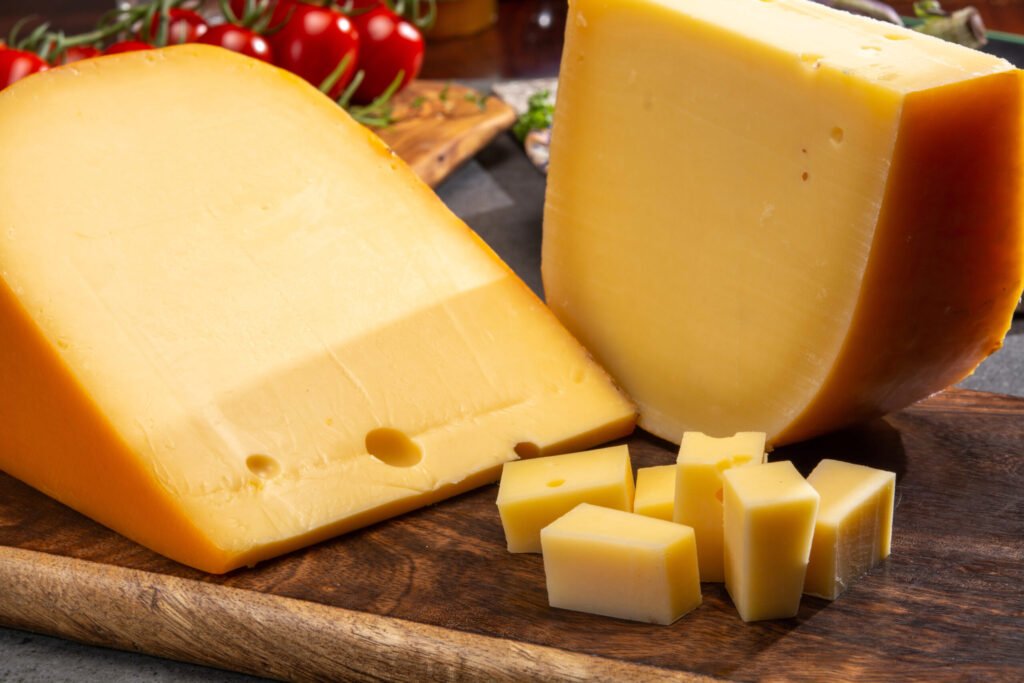Introduction: The Worldwide Appeal of Gouda Cheese
Gouda cheese is a culinary icon—creamy, mild, and deeply comforting when young, yet bold, complex, and caramel-like when aged. Originating from the Netherlands, Gouda has become one of the most widely consumed cheeses in the world, adored for its versatility in cooking, snacking, and pairing.
Whether you’re wondering “What is Gouda cheese?”, curious about the Gouda cheese flavor profile, or trying to choose the best Gouda cheese in the world, this guide gives you everything you need to know.
Origins of Gouda Cheese
Gouda derives its name from the Dutch city of Gouda, a historical center for cheese trade rather than the place of production. Dating back to the 12th century, Gouda has roots in traditional Dutch farmhouse cheesemaking.
Traditionally, Gouda was made from raw cow’s milk on family farms. Today, Gouda is produced globally—from the Netherlands and the U.S. to New Zealand and even India—yet authentic Dutch Gouda remains the gold standard, especially Protected Designation of Origin (PDO) versions like:
-
Noord-Hollandse Gouda
-
Boerenkaas (Farmhouse Gouda)
What Is Gouda Cheese?
Gouda is a semi-hard to hard cheese, depending on its age. It is usually made from cow’s milk, though goat’s milk and sheep’s milk Gouda varieties also exist. The cheese is washed-curd, meaning the curds are rinsed to reduce acidity, creating a sweeter, milder flavor.
The Gouda Cheese Taste Profile

If you’re searching for “Gouda cheese taste profile” or “what does Gouda cheese taste like?”, here’s a detailed breakdown.
1. Young Gouda (Jong / Mild)
-
Soft and creamy
-
Buttery and slightly sweet
-
Pale yellow interior
-
Smooth, elastic texture
-
Mild aroma
2. Aged Gouda (Aged, Extra Aged, “Oude”)
-
Deep caramel or butterscotch notes
-
Dense, firm, and crumbly
-
Rich umami
-
Crystals (tyrosine) that add crunch
-
Darker, amber-colored interior
3. Smoked Gouda
-
Distinct smoky aroma
-
Creamier due to added cream (in many versions)
-
Popular for sandwiches, pizzas, and snacking
4. Flavored Gouda
Includes fenugreek, cumin, chili, herbs, or truffle versions.
Gouda Cheese Texture: What to Expect
Textures vary depending on age:
| Age | Texture |
|---|---|
| Young (1–3 months) | Semi-soft, creamy, smooth |
| Medium-aged | Firm but sliceable |
| Aged (8–12+ months) | Hard, crumbly, caramel-like |
If you’re wondering “Is Gouda soft cheese?” — Young Gouda is semi-soft, while aged Gouda becomes quite firm or hard.
Is Gouda Cheese Aged?
Yes. Gouda can be aged anywhere from 4 weeks to over 5 years.
Common Aging Categories
-
Young (Jong): 1–3 months
-
Mature (Belegen): 4–6 months
-
Aged (Oude): 10–12 months
-
Very Aged (Extra Oude): 2–3 years
-
Vintage/Reserve Gouda: 3–5+ years
The more it ages, the sharper, nuttier, and more complex the flavor.
How Gouda Cheese Is Made
1. Milk Selection
Usually cow’s milk, sometimes goat or sheep.
2. Curdling and Cutting
Rennet is added, and the curds are cut into small pieces.
3. Washed-Curd Process
Curds are rinsed with warm water to remove lactose, which results in a sweeter cheese.
4. Pressing and Shaping
Curds go into molds, forming Gouda’s characteristic wheels.
5. Brining
Cheese wheels are soaked in brine for flavor and rind formation.
6. Aging
Cheese is placed in aging rooms where flavor develops over time.
Gouda Cheese Around the World
Netherlands
Home of traditional and PDO Gouda.
United States
Produces mild and smoked Gouda varieties.
New Zealand
Known for consistently high-quality aged Gouda.
Eastern Europe
Smoked Gouda is popular in the Balkans and Central Europe.
Middle East & Asia
Local Gouda versions are becoming widely available in supermarkets.
Popular Uses of Gouda Cheese
Gouda is incredibly versatile:
-
Sandwiches & Paninis
-
Cheese platters (pairs well with fruits & nuts)
-
Pizzas & flatbreads
-
Mac and cheese
-
Cheese sauces
-
Burgers
-
Grilled cheese
-
Soups
For cooking, young Gouda melts best. For snacking, aged Gouda shines.
Nutritional Facts of Gouda Cheese
-
High in protein
-
Good source of calcium
-
Contains vitamins A, B12, and K2
-
Rich in beneficial fats
-
Aged Gouda is often lower in lactose
Per 1 oz (28g)
-
Calories: ~110
-
Protein: 7g
-
Fat: 9g
-
Calcium: 20% DV
How to Store Gouda Cheese
-
Wrap in parchment or cheese paper
-
Store in the cheese drawer or lowest fridge shelf
-
Keep away from strong-smelling foods
-
Use airtight containers for shredded Gouda
-
Aged Gouda can last several weeks if stored properly
Choosing the Best Gouda Cheese in the World
Look for:
-
PDO-certified Dutch Gouda
-
Farmhouse Boerenkaas
-
Aged or ultra-aged varieties
-
Raw-milk options for more flavor
Brands like Old Amsterdam, Beemster, and Reypenaer are global favorites.
FAQs About Gouda Cheese
1. What is Gouda cheese?
Gouda is a semi-hard Dutch cheese known for its creamy texture and mild-to-strong flavor depending on age.
2. What does Gouda cheese taste like?
Young Gouda is buttery and mild, while aged Gouda is caramel-like, nutty, and complex.
3. Does Gouda melt well?
Yes—especially young Gouda, which melts smoothly in sauces and sandwiches.
4. Is Gouda cheese healthy?
Yes, Gouda offers calcium, protein, and vitamin K2, making it a nutritious option in moderation.
5. Is Gouda lactose-free?
Aged Gouda is typically very low in lactose, making it easier to digest.



